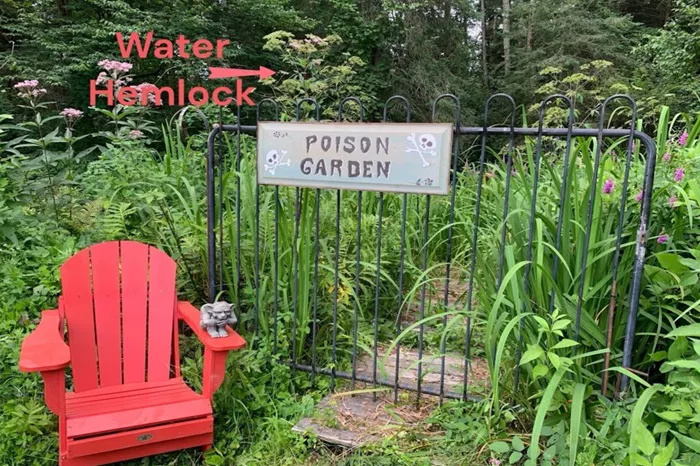This article takes inspiration from the famous Poison Garden at Alnwick Castle in the U.K. This garden showcases some of the world’s most dangerous plants. It serves as a living reminder of nature’s duality—beauty intertwined with danger. Visitors often find themselves struck by the contrast between the garden’s lush greenery and the warning signs advising them against touching or smelling the plants.
As a garden writer, I have often been captivated by the alluring charm of certain plants, only to discover their hidden dangers. This story is not just about their beauty; it also serves as a reminder of their potential hazards, especially for those who wander too close—whether children, pets, or even seasoned gardeners.
The Castor Bean
One notable example is the castor bean (Ricinus communis). With its lush, tropical leaves and striking red seed pods, it transforms any garden into a tropical paradise. However, beneath its exotic appearance lies ricin, one of the most potent toxins known to humans. The Guinness Book of World Records even names it the world’s most poisonous plant.
Interestingly, despite its toxic seeds, the castor bean plant is also the source of castor oil. This product has been used for centuries in various applications, from medicinal to industrial. The oil itself is safe because the ricin toxin is not soluble in oil and is removed during the extraction process.
Harvesting the seed pods of the castor bean can be an adventure. I remember my first attempt; I was nervous about the pods exploding. They popped and scattered seeds everywhere, which made me anxious. That experience was enough for me to decide against growing these beauties again.
Monkshood
Then there’s monkshood (Aconitum napellus). Known as the “Queen of Poisons,” this plant features regal purple flowers. Its history is rich in folklore and medicine. The toxin aconitine can cause numbness, tingling, gastrointestinal distress, and even cardiac arrest. Despite its enchanting blooms, touching this plant can be dangerous, making it a queen with a lethal kiss.
Walking through the garden, I also noticed the striking water hemlock (Cicuta maculata). Its smooth stems, marked with purplish-red streaks, and delicate leaves stand in contrast to sturdier stems. Clusters of tiny white flowers atop the plant attract bees and butterflies.
Often confused with Queen Anne’s Lace, this plant contains cicutoxin, a potent poison that can cause seizures, abdominal pain, and respiratory failure. The allure of its lace-like blooms can be irresistible, but a closer look reveals more than just a spotted stem—it exposes the plant’s deadly nature.
Children sometimes use the hollow stems of water hemlock as pea shooters, unaware of the severe risks. Even minimal contact with its toxic sap can cause serious harm. It is essential to teach children to avoid these enticing yet dangerous plants.
Poison Hemlock
Another deceptive beauty is poison hemlock (Conium maculatum). Though it shares a name, it does not inhabit the same wet areas as its water-loving relative. Poison hemlock often grows along roadsides and in fields. It has fern-like leaves and clusters of small white flowers. This plant has a notorious history; it was famously used to execute the Greek philosopher Socrates. The toxin coniine can cause paralysis, leading to respiratory failure and death if ingested.
Foxglove (Digitalis purpurea) is a fascinating yet perilous plant in my garden. Its spires of purple, pink, and white flowers add spectacular vertical accents and attract bees and other pollinators. However, foxglove contains cardiac glycosides, which can affect heart function.
Despite its toxicity, foxglove is important in medicine. Digitalis, derived from the plant, treats heart conditions and has saved countless lives.
As a homeopath, I often think about the fine line between poison and medicine. Many powerful homeopathic remedies come from toxic plants, diluted to safe levels to heal rather than harm. Foxglove symbolizes this balance—its beauty and danger reflect the dual nature of many natural substances that can both kill and cure.
Other Dangerous Plants
Here are some other plants to be cautious of: poison ivy, giant hogweed, belladonna, bracken ferns, and lily of the valley.
Even everyday garden staples, like potatoes, can harbor dangers. Spoiled potatoes can develop high levels of solanine, especially in the green parts, sprouts, and rotting areas. Eating these can cause nausea, vomiting, and severe neurological symptoms. Always store potatoes properly, away from light, and discard any that show signs of spoilage.
Rhubarb, a favorite for pies and jams, also poses risks. While the stalks are safe to eat, the leaves contain oxalic acid and anthraquinone glycosides, making them highly toxic.
As gardeners, we are often enchanted by the beauty and variety of plants that can transform our outdoor spaces. However, it is crucial to recognize and respect the hidden dangers some of these plants pose. Remember this tale and let your garden be a source of joy, not peril. Like the Poison Garden in the U.K., let our gardens serve as a living lesson in the dual nature of beauty and danger.
Related topics:


